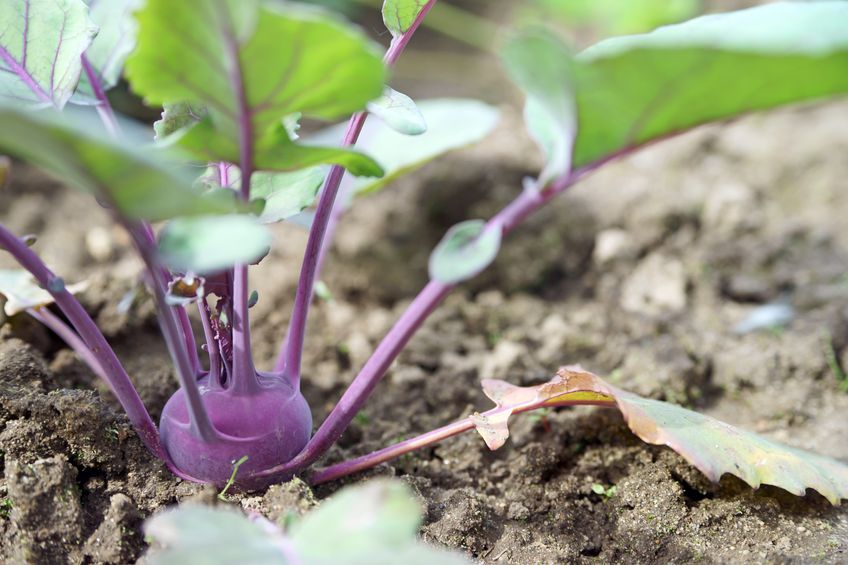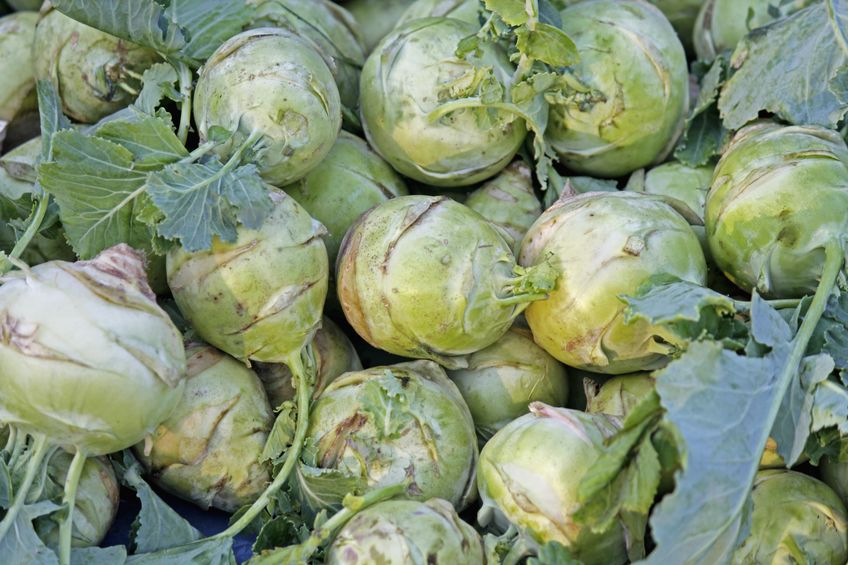Kohlrabi
Kohlrabi (Brassica oleracea var. gongylodes L.), the often magenta-red or white stem bulb with green leaves, belongs to the brassica family. Despite its somewhat unusual appearance, it has a rather sweet and mild flavor when cooked. Kohlrabi is also easy to cultivate and grows quickly, making it ideal even for gardening beginners.

Planting time – When is best?
From early spring you can sow under cover, and from the end of March you can also sow directly into the bed.
Kohlrabi cultivation – how does it work?
While it's still cold, sow the seeds indoors in pots or seed trays two centimeters deep. When the seedlings reach a height of 5 cm, transplant them; otherwise, they tend to bolt. In the garden, the distance between rows should be 30 cm, and between individual plants 25 cm. Please be careful with the roots when transplanting; they are somewhat delicate.
Outdoors, you can only sow when the temperature is consistently above 10 degrees Celsius, as otherwise the kohlrabi plants will start to shoot. Three seeds are sown per planting site, and later only the strongest plant is left standing.
Location – Where is best?
Kohlrabi thrives best in neutral, humus-rich soils with high nutrient and water content. However, it generally thrives in almost any soil.
Care – What needs to be done?
Kohlrabi needs regular watering to prevent the tubers from bursting. You should also weed regularly and fertilize a little if necessary, but otherwise, there's not much to do.
Harvest – What should you consider?
Depending on the variety, kohlrabi is ready for harvest two to three months after sowing. The best time to harvest is when the tubers have reached the size of a tennis ball. The tubers taste best when young and tender.
To harvest, cut the kohlrabi below the bulb and remove the larger leaves. The tender inner leaves are also edible.
Spring and summer varieties should be consumed quickly after harvest. They can be stored in the refrigerator without leaves for a few days, but freezing is also possible.
Autumn varieties can be stored for months in cool places such as cellars.

Mixed culture – What are good neighbors?
Beans, borage, dill, peas, strawberries, cucumbers, fennel, potatoes, leeks, radishes, beetroot, lettuce, salsify, celery, asparagus and spinach go well with kohlrabi.
Botany – What kind of plant is this?
Kohlrabi belongs to the cruciferous family and is a biennial plant that is harvested in the first year. The rounded tuber is not a root, but actually just a thickening of the stem. It has a diameter of 5 to 20 cm and is white, green, reddish, or purple in color. The tuft of leaves consists of long-stemmed, dark green leaves that are ovate and usually very toothed.
Kohlrabi contains many important vitamins, minerals and fiber – important for good digestion and a healthy diet.
Cultural history – How did kohlrabi come to us?
Like many cabbage varieties, kohlrabi is descended from wild cabbage, although its exact origin is unclear. It has been known in Central Europe since the 16th century, having been recorded and mentioned in herbal books. In Germany, the colorful turnip has always been popular, and it was cultivated extensively, especially in the 19th century.
Because it was and is widely cultivated here, it is considered a typically German vegetable. Therefore, the German name has been adopted into many languages, including English, Russian, and Japanese. Kohlrabi still enjoys great popularity here today.
TEXT: Merle Hildebrandt








































































































